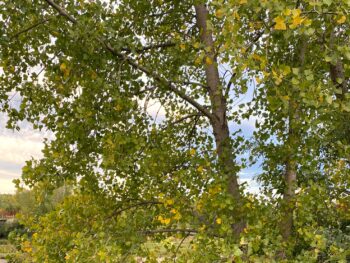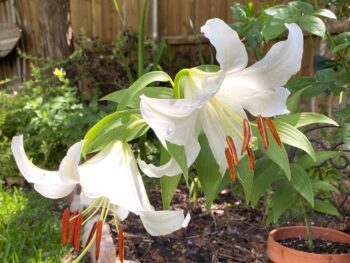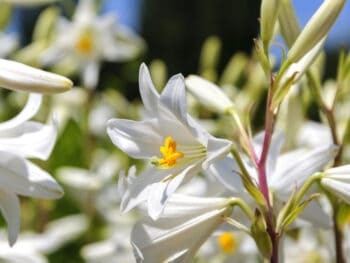‘Tis the season for greenery! How glorious to celebrate Christmas by decking the halls with evergreen boughs – their faithful hues and fresh fragrance soothing and triumphant all in one whiff! Wreaths, garlands, and Christmas trees add wonder; God’s Word agrees, proclaiming the glory of bringing in branches to beautify:
The glory of Lebanon will come to you, the juniper, the fir and the cypress together, to adorn my sanctuary
Isaiah 60:13 NIV
Discovering this place of evergreen congregation in the Bible, and a similar passage in Isaiah 41:19-20, whispered a creative whim to my inner garden-designer. Why not plant a little “glory of Lebanon” in our yard, refreshing us with Christmas wonder all year long?
Landscaping plans rely on many of the evergreen plants on this list, or species similar to them, to screen foundations, gas meters, A/C units, and the like, giving neighbors more pleasing views. Along the west side of our house, the former hedges had grown dull and scraggily; how much more invigorating to replace them with a few fresh scents and flowering shrubs from Isaiah’s promise of the Lord’s thirst-quenching revival (Isaiah 41:17-18)?!
Isaiah’s Plant List
These passages of Scripture have always been a botanical challenge, as the original Hebrew words indicating the plant identities are not straightforward. What NIV translators have called “fir” and “cypress” have been designated laurustinus and boxwood by other researchers. Furthermore, Michael Zohary, author of Plants of the Bible and former Chair of Botany at the Hebrew University of Jerusalem, considered the single term translated “juniper” in the NIV to be “a collective name for three species [Evergreen Cypress, Cicilian Fir, and Eastern Savin, a juniper].”
Yet this conifer conundrum is good news for those who love to garden, opening up Isaiah’s lists to include a wider range of plant material, including broadleafs among the traditional Christmas tree types.
In the days of his revealing, [God] will plant the soaring species with understory trees, so abundantly full is his forest.
—from “Lay of the Land” for the Cedars of Lebanon landscape, NIV God’s Word for Gardeners Bible
Additionally, the prophet spoke of water-wise evergreens whose home borders the desert: acacia, olive, and myrtle. Marrying the desert dwellers with the majestic highland trees once again reminds us of God’s expanse, planting everything from the wasteland to the forest together, refreshing us with the glory of his possibility and mighty strength.
… so that people may see and know, may consider and understand, that the hand of the Lord has done this, that the Holy One of Israel has created it.
Isaiah 41:20 NIV
Then you will know that I, the Lord, am your Savior, your Redeemer, the Mighty One of Jacob.
Isaiah 60:16 NIV
Planting a Glory of Lebanon Garden
Imagining the “glory of Lebanon” brought grander delight to an otherwise lackluster homeowners’ mandate to conceal our foundation and A/C compressors along the sideyard. Our clay soils are not the greatest host to firs, but boxwood endures nearly any condition, and I was happy to learn more about laurustinus, its spring flowers sweet-scented and showy. Both plants should take the shady morning exposure in stride.
And now for artistic license (i.e. NOT Bible plant additions): Bald cypress trees, dwarf Atlas cedar, ever-blooming azaleas, and a crepe myrtle.

Gardener’s Scrapbook








“AFTER:” Evergreens all tucked in! Limestone edging connects a Texas garden to the Holy Land. The mountains of Lebanon, home to the great cedar, juniper, and fir are made of limestone, though these rocks are locally “grown.”
May God’s glorious truth echo to all who pass by here: “that the Holy One of Israel has created” everything, from the little blue to the splendid cedar of Lebanon!
Discover more in the Plant Guide:
Boxwood – gardenndestage.wpengine.com/plant-guide/boxwood/
Cedar of Lebanon – gardenndelight.wpengine.com/plant-guide/cedar-lebanon/
Laurustinus – gardenndelight.wpengine.com/plant-guide/laurustinus/
Visit J. Berry Nursery for more information on ever-blooming azaleas and dark-leaved crepe myrtles.
All photos ©2014 Shelley S. Cramm except the Black Diamond Crepe Myrtle















